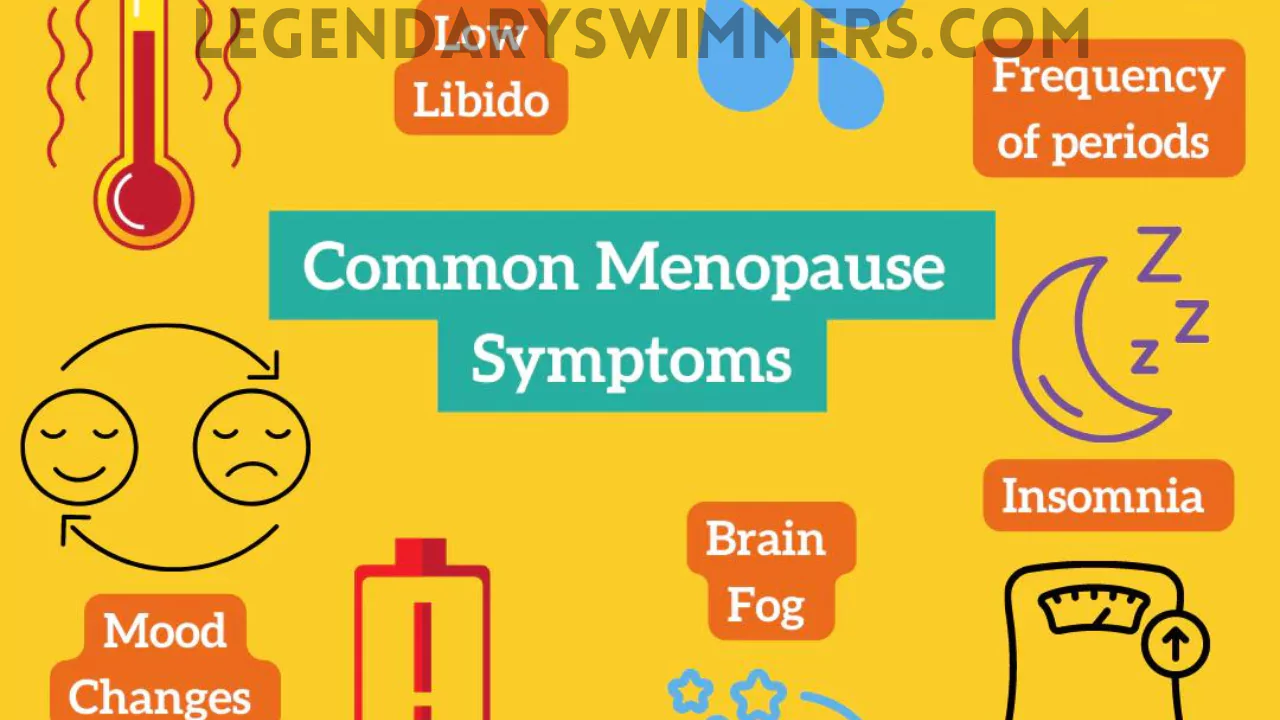
Best Swimming Practices for Menopausal Women (2024)
- Updated:
Menopause is a natural phase in a woman’s life, typically occurring between the ages of 45 and 55, characterized by the end of menstrual cycles and various hormonal changes. This transition can bring about numerous symptoms, such as hot flashes, mood swings, and sleep disturbances. Despite these challenges, engaging in regular physical activity can significantly improve overall well-being. Among the various forms of exercise, swimming stands out as an excellent option for menopausal women.
According to the UCL study, a significant number of menopausal women reported improvements in various symptoms after engaging in cold water swimming. 46.9% experienced reduced anxiety, 34.5% noticed fewer mood swings, and 31.1% reported a decrease in low mood. Additionally, 30.3% of participants experienced a reduction in hot flashes.
Brief Overview of Menopause
Menopause is officially defined as the absence of a menstrual period for 12 consecutive months. This transition typically begins with perimenopause, which can start in a woman’s 30s or 40s and lasts until menopause itself. The average age of menopause is 51, but individual experiences can vary widely.
Menopausal Symptoms and How Swimming Can Help

| Symptom | Description | How Swimming Can Help |
|---|---|---|
| Hot Flashes | Sudden feelings of heat, often accompanied by sweating | Regular exercise can reduce the frequency and severity of hot flashes. |
| Mood Swings | Emotional fluctuations that can include anxiety, irritability, or sadness | Swimming releases endorphins, which can elevate mood and reduce anxiety. |
| Sleep Disturbances | Trouble falling or staying asleep | Physical activity has been shown to improve sleep patterns. |
| Weight Gain | Hormonal changes can lead to changes in body composition | Swimming can help burn calories and maintain a healthy weight. |
| Joint Pain | Increased joint discomfort may occur during this time | The low-impact nature of swimming can help reduce joint stress. |
Benefits of Swimming for Menopausal Women
Engaging in regular physical activity, particularly swimming, can offer numerous benefits for menopausal women. Swimming provides a full-body workout that enhances cardiovascular fitness, builds muscle strength, and improves flexibility without placing excessive strain on the joints.
Low-Impact Exercise and Joint Health
Swimming is a low-impact exercise, making it gentle on the joints. This is especially beneficial for menopausal women who may experience increased joint pain and stiffness. The buoyancy of water supports the body, allowing for easier movement and reducing the risk of injury.
According to a study published in the Journal of Physical Activity & Health, low-impact activities like swimming can significantly alleviate joint pain and improve mobility in older adults.
Cardio Fitness and Weight Management
Swimming is an excellent cardiovascular workout, helping to improve heart health and endurance. It can also aid in weight management, as it burns calories effectively. Research indicates that regular swimming can help prevent weight gain during menopause, which is a common concern.
The American College of Sports Medicine recommends at least 150 minutes of moderate-intensity aerobic activity, like swimming, each week to maintain a healthy weight.
Muscle Strength and Tone
Swimming engages multiple muscle groups, promoting strength and toning. Regular swimming sessions can enhance overall muscle tone and improve metabolic rate, which can decrease during menopause. According to a study by the Mayo Clinic, engaging in strength training activities, including swimming, can help offset muscle loss due to aging.
Mental and Emotional Benefits
Exercise, particularly swimming, can be a great stress reliever. The rhythmic nature of swimming promotes relaxation, while the release of endorphins can elevate mood. Studies show that women who swim regularly report lower levels of anxiety and depression.
A review in the Journal of Clinical Psychiatry highlights that aerobic exercises, including swimming, can effectively reduce symptoms of depression.
Improved Sleep Quality
Swimming can significantly enhance sleep quality, particularly during menopause when sleep disruptions are common. Regular physical activity helps regulate sleep patterns by promoting the release of endorphins and reducing stress levels, both of which are crucial for a good night’s rest.
Swimming, as an aerobic exercise, increases body temperature, and the subsequent drop in temperature after swimming can signal to the body that it’s time to sleep. Research published in the Journal of Clinical Sleep Medicine shows that consistent aerobic exercise can significantly improve sleep quality and reduce insomnia.
Social Interaction and Community Building
Joining a swimming group or class can foster social connections, reducing feelings of isolation and loneliness. Engaging with others in a supportive environment can enhance motivation and enjoyment of the activity. American Psychological Association (APA) has published research highlighting the positive impact of exercise, including swimming, on mental health and well-being.
Recommended Swimming Practices
If you are new to swimming, consider enrolling in swim lessons to learn proper techniques. Focus on mastering basic strokes like freestyle and breaststroke. Look for classes designed specifically for adults or beginners to ensure a supportive environment.
Prior to swimming, it’s essential to perform a proper warm-up to enhance your performance and reduce the risk of injury. Engaging in dynamic stretches, such as arm circles and leg swings, helps to gradually increase blood flow to your muscles and joints. These movements promote flexibility and mobility, ensuring that your body is primed for the demands of swimming.
Community pools and local swim clubs often offer classes and group sessions tailored for all skill levels. Joining a local swim group can enhance your experience and provide additional motivation.
Navigating Menopause: Importance of Hydration
Staying hydrated is crucial for overall health, especially during menopause, when hot flashes and other symptoms can lead to increased sweating and fluid loss. Proper hydration helps regulate body temperature and can mitigate the intensity of hot flashes.
Research from the Journal of Women’s Health emphasizes the importance of hydration in managing menopausal symptoms, noting that adequate fluid intake can help reduce the frequency of hot flashes and improve overall comfort.
A balanced diet rich in whole grains, lean proteins, fruits, and vegetables is vital for sustaining energy levels during menopause. Proper nutrition can help manage weight, support muscle health, and improve overall well-being.
Consider seeking advice from a registered dietitian or nutritionist to tailor your diet to your specific needs during menopause. They can provide personalized meal plans and help you navigate any dietary changes. The North American Menopause Society recommends nutritional modifications to help manage menopause-related symptoms.
Choosing Appropriate Swimwear
Select swimwear that is breathable and moisture-wicking to enhance comfort in the water. Look for styles that allow for ease of movement. Incorporating stretching before and after your swim can prevent injuries and improve flexibility. Focus on gentle stretches for the arms, legs, and back.
Pay attention to how your body feels during and after swimming. If you experience pain or discomfort, take a break and consult with a healthcare professional if needed.
FAQs:
Why is Swimming Recommended for Menopausal Women?
Swimming addresses specific menopausal challenges by providing a low-impact workout that promotes cardiovascular health, muscle strength, and mental well-being. Its soothing nature can also help alleviate symptoms like hot flashes and mood swings.
How Can I Find a Swimming Group or Class?
Look for local community centers or fitness clubs that offer swimming classes. Online platforms can also help you find swimming groups in your area. Joining a group can enhance your experience and provide support.
What If I Haven’t Swum in Years?
If you’re returning to swimming after a long break, start slowly. Consider taking beginner lessons to refresh your skills and build confidence in the water.
How to Maintain Motivation to Swim Regularly?
Set a schedule that includes swimming sessions and stick to it. Finding a swim buddy can also help keep you accountable. Mix up your routine to keep it fresh and enjoyable.
Conclusion
Swimming offers numerous benefits for menopausal women, including improved physical fitness, mental health, and social interaction. By incorporating swimming into your routine, you can effectively manage menopausal symptoms while enhancing your overall quality of life.
Ready to dive in? Join us at Legendary Swimmers for swimming classes and explore our range of products tailored to your aquatic needs, including Kiefer rings for hydrotherapy, Aqua Swim Bar, and shorty wetsuits for comfort in the water. Start your journey to better health and well-being today!
References:
- UCL EGA Institute for Women’s Health
- Mayoclinic
- Journal of Physical Activity & Health
- North American Menopause Society
- American Psychological Association
- American College of Sports Medicine

Natasha Nicole Leyva
Hi, I’m Natasha—swimmer, coach, and aquatic fitness enthusiast. My journey began in New Zealand after a professor recommended swimming to help with a knee injury. The low-impact nature of swimming worked wonders, and it quickly became my favorite form of exercise. This passion grew into a thriving swim academy, and soon, requests for aquatic fitness classes started pouring in. After becoming certified, I realized how powerful water workouts could be for recovery and fitness. Now, I share my expertise here to help others experience the benefits of aquatic movement—whether for recovery, fitness, or fun!






